Related Research Articles
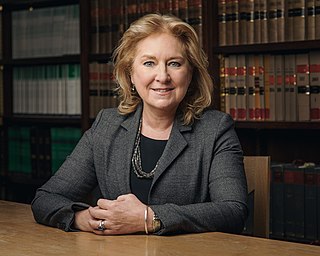
The Lord or Lady Chief Justice of England and Wales is the head of the judiciary of England and Wales and the president of the courts of England and Wales.
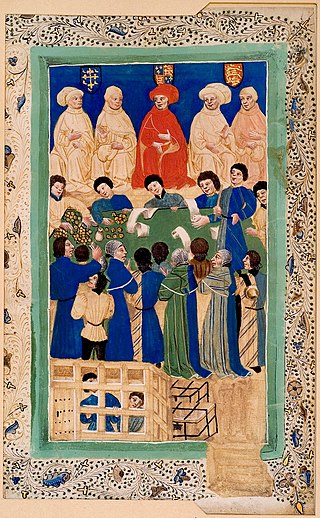
The Exchequer of Pleas, or Court of Exchequer, was a court that dealt with matters of equity, a set of legal principles based on natural law and common law in England and Wales. Originally part of the curia regis, or King's Council, the Exchequer of Pleas split from the curia in the 1190s to sit as an independent central court. The Court of Chancery's reputation for tardiness and expense resulted in much of its business transferring to the Exchequer. The Exchequer and Chancery, with similar jurisdictions, drew closer together over the years until an argument was made during the 19th century that having two seemingly identical courts was unnecessary. As a result, the Exchequer lost its equity jurisdiction. With the Judicature Acts, the Exchequer was formally dissolved as a judicial body by an Order in Council on 16 December 1880.
Thomas Charlton was Bishop of Hereford, Lord High Treasurer of England, Lord Privy Seal, and Lord Chancellor of Ireland. He is buried in Hereford Cathedral in Hereford, Herefordshire, England.
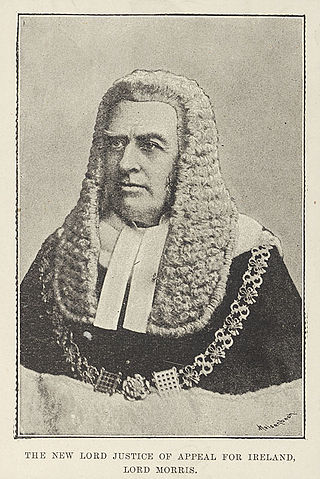
The Attorney-General for Ireland was an Irish and then, from 1801 under the Acts of Union 1800, United Kingdom government office-holder. He was senior in rank to the Solicitor-General for Ireland: both advised the Crown on Irish legal matters. With the establishment of the Irish Free State in 1922, the duties of the Attorney-General and Solicitor-General for Ireland were taken over by the Attorney General of Ireland. The office of Solicitor-General for Ireland was abolished at the same time for reasons of economy. This led to repeated complaints from the first Attorney General of Ireland, Hugh Kennedy, about the "immense volume of work" which he was now forced to deal with single-handedly.
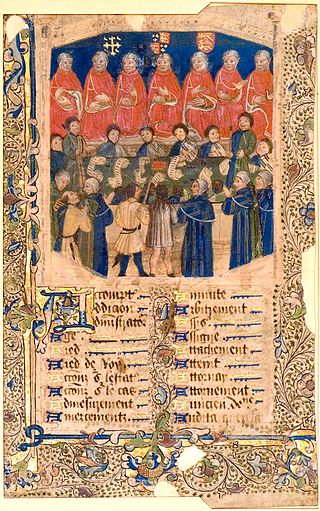
The Court of Common Pleas, or Common Bench, was a common law court in the English legal system that covered "common pleas"; actions between subject and subject, which did not concern the king. Created in the late 12th to early 13th century after splitting from the Exchequer of Pleas, the Common Pleas served as one of the central English courts for around 600 years. Authorised by Magna Carta to sit in a fixed location, the Common Pleas sat in Westminster Hall for its entire existence, joined by the Exchequer of Pleas and Court of King's Bench.
Hervey de Stanton was an English judge and Chancellor of the Exchequer.
Sir Henry le Scrope was an English lawyer, and Chief Justice of the King's Bench for two periods between 1317 and 1330. He was the eldest son of Sir William le Scrope, who was bailiff to the earl of Richmond in Richmondshire. Henry's younger brother Geoffrey was also a lawyer who probably advanced through the influence of his older brother. Geoffrey served as Chief Justice four times between 1324 and 1338.
Sir John Stonor SL (1281–1354) was an English judge and the first notable member of the influential Stonor family. He was the son of Richard Stonor, an Oxfordshire freeholder, with the family name coming from the village of Stonor. After training as a lawyer he was called to the Common Bench as a Serjeant-at-law in 1311, being made a King's Serjeant in 1315 and a justice of the Common Bench on 16 October 1320. He held this position until 1329, other than a period as a justice for the King's Bench between July 1323 and 4 May 1324; in 1324 he was also knighted. On 22 February 1329 he was made Lord Chief Baron of the Exchequer and was made Chief Justice of the Common Pleas on 3 September. He was removed from this position on 2 March 1331, however, possibly due to Edward III, who replaced important officers after he was crowned; there is, however, no evidence that Stonor was politically active.
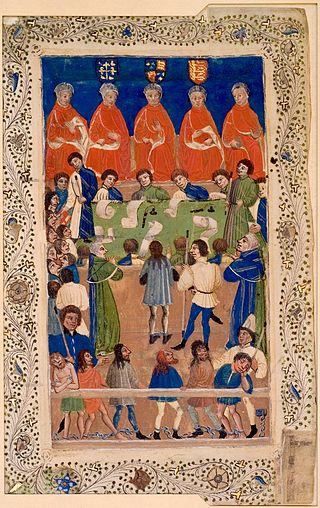
The Court of King's Bench, formally known as The Court of the King Before the King Himself, was a court of common law in the English legal system. Created in the late 12th to early 13th century from the curia regis, the King's Bench initially followed the monarch on his travels. The King's Bench finally joined the Court of Common Pleas and Exchequer of Pleas in Westminster Hall in 1318, making its last travels in 1421. The King's Bench was merged into the High Court of Justice by the Supreme Court of Judicature Act 1873, after which point the King's Bench was a division within the High Court. The King's Bench was staffed by one Chief Justice and usually three Puisne Justices.

The Court of King's Bench was one of the senior courts of common law in Ireland. It was a mirror of the Court of King's Bench in England. The King's Bench was one of the "Four Courts" which sat in the building in Dublin which is still known as "The Four Courts", and is still in use.
Sir Roger Hillary was an English judge. He was one of five sons of William Hillary and his wife Agnes, a landowning family which held properties in Lincolnshire, Warwickshire, Staffordshire, and Leicestershire, and appear to have been related to Sir William Bereford, the Chief Justice of the Common Pleas; a useful connection for a nascent lawyer. In 1310 Hillary was recorded as a court attorney, and in 1324 he was made a Serjeant-at-law. In the later years of Edward II's reign Hillary kept a low profile. In spring 1320 he married Katherine, and added to his property portfolio the Manor of Fisherwick near Lichfield in 1327 and a life-grant of a mill at Bentley at around the same time.
Sir William Hankford, also written Hankeford, of Annery in Devon, was an English lawyer who acted as Chief Justice of the King's Bench from 1413 until 1423.

The chief justice of the Common Pleas for Ireland was the presiding judge of the Court of Common Pleas in Ireland, which was known in its early years as the Court of Common Bench, or simply as "the Bench", or "the Dublin bench". It was one of the senior courts of common law in Ireland, and was a mirror of the Court of Common Pleas in England. The Court of Common Pleas was one of the "four courts" which sat in the building in Dublin which is still known as the Four Courts, apart from a period in the fourteenth century when it relocated to Carlow, which was thought, wrongly as it turned out, to be both more central and more secure for the rulers of Norman Ireland.

The Court of Common Pleas was one of the principal courts of common law in Ireland. It was a mirror image of the equivalent court in England. Common Pleas was one of the four courts of justice which gave the Four Courts in Dublin, which is still in use as a courthouse, its name. Its remit as in England was to hear lawsuits between ordinary citizens.
Sir Elias de Asshebournham, or Ellis de Ashbourne was an Irish judge who held the office of Lord Chief Justice of Ireland, and fought a long battle with a rival candidate, Thomas Louth, to retain it. Despite frequent allegations of corruption, and a reputation for violence, for many years he retained the confidence of the English Crown, although he also suffered periods of imprisonment.
William de Rodyard, de Rodiard, or de Rudyard was an English-born judge and cleric in fourteenth-century Ireland. He held office as Chief Justice of the Irish Common Pleas. He was also Dean of St Patrick's Cathedral, and briefly Deputy Lord Treasurer of Ireland. He was the first Chancellor of the Medieval University of Dublin.
Robert Sutton was an Irish judge and Crown official. During a career which lasted almost 60 years he served the English Crown in a variety of offices, notably as Deputy to the Lord Chancellor of Ireland, Chief Baron of the Irish Exchequer, Master of the Rolls in Ireland, and Deputy Treasurer of Ireland. A warrant dated 1423 praised him for his "long and laudable" service to the Crown.

Thomas de Dent, Thomas Dyvelyn, Thomas Denton, or Thomas of Dublin was an English-born cleric and judge who held high office in Ireland during the reign of King Edward III, and was praised as a diligent and hard-working Crown official, who damaged his health through overwork.
John de Ponz, also called John de Ponte, John Savan, or John of Bridgwater (c.1248–1307) was an English-born administrator, lawyer and judge in the reign of King Edward I. He served in the Royal Household in England for several years before moving to Ireland, where he practised in the Royal Courts as the King's Serjeant-at-law (Ireland). He later served as a justice in eyre, and then as a justice of the Court of Common Pleas (Ireland). He was a gifted lawyer, but as a judge was accused of acting unjustly. A case he heard in Kilkenny in 1302 can be seen as a precursor of the Kilkenny Witchcraft Trials of 1324, and involved several of the main actors in the Trials.
David le Blond was an Irish judge in the reign of King Edward II of England, who was notorious for corruption.
References
- ↑ Cal. Rot. Pat. 94 b, 95 b, 96, 97, 99 b; the Irish Close Rolls, i. 34, 35, speak of him as Chief Justice of the Irish King's Bench in 1327).
![]() This article incorporates text from a publication now in the public domain : "Hambury, Henry de". Dictionary of National Biography . London: Smith, Elder & Co. 1885–1900.
This article incorporates text from a publication now in the public domain : "Hambury, Henry de". Dictionary of National Biography . London: Smith, Elder & Co. 1885–1900.